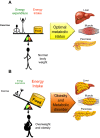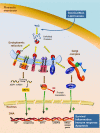"Mens sana in corpore sano": exercise and hypothalamic ER stress
- PMID: 20808779
- PMCID: PMC2927527
- DOI: 10.1371/journal.pbio.1000464
"Mens sana in corpore sano": exercise and hypothalamic ER stress
Abstract
A novel mechanism explains how exercise exerts its beneficial effects on energy balance through an effect at the level of the hypothalamus.
Conflict of interest statement
The authors have declared that no competing interests exist.
Figures



Comment on
- PLoS Biol. 8:e1000465.
Similar articles
-
[Mens sana in corpore sano].Enfoque. 1983 Mar;11(1):3. Enfoque. 1983. PMID: 6552211 Portuguese. No abstract available.
-
IL-6 and IL-10 anti-inflammatory activity links exercise to hypothalamic insulin and leptin sensitivity through IKKbeta and ER stress inhibition.PLoS Biol. 2010 Aug 24;8(8):e1000465. doi: 10.1371/journal.pbio.1000465. PLoS Biol. 2010. Retraction in: PLoS Biol. 2023 Apr 4;21(4):e3002079. doi: 10.1371/journal.pbio.3002079. PMID: 20808781 Free PMC article. Retracted.
-
Mens sana in corpore sano.Ann Intern Med. 2006 Jan 17;144(2):135-6. doi: 10.7326/0003-4819-144-2-200601170-00011. Ann Intern Med. 2006. PMID: 16418413 No abstract available.
-
Hypothalamic dysfunction in obesity.Proc Nutr Soc. 2012 Nov;71(4):521-33. doi: 10.1017/S002966511200078X. Epub 2012 Sep 6. Proc Nutr Soc. 2012. PMID: 22954151 Review.
-
Hypothalamic obesity in children: pathophysiology to clinical management.J Pediatr Endocrinol Metab. 2015 May;28(5-6):503-13. doi: 10.1515/jpem-2014-0512. J Pediatr Endocrinol Metab. 2015. PMID: 25781673 Review.
Cited by
-
Central ceramide-induced hypothalamic lipotoxicity and ER stress regulate energy balance.Cell Rep. 2014 Oct 9;9(1):366-377. doi: 10.1016/j.celrep.2014.08.057. Epub 2014 Oct 2. Cell Rep. 2014. PMID: 25284795 Free PMC article.
-
Hypothalamic kappa opioid receptor mediates both diet-induced and melanin concentrating hormone-induced liver damage through inflammation and endoplasmic reticulum stress.Hepatology. 2016 Oct;64(4):1086-104. doi: 10.1002/hep.28716. Epub 2016 Aug 9. Hepatology. 2016. PMID: 27387967 Free PMC article.
-
Genetic Targeting of GRP78 in the VMH Improves Obesity Independently of Food Intake.Genes (Basel). 2018 Jul 17;9(7):357. doi: 10.3390/genes9070357. Genes (Basel). 2018. PMID: 30018241 Free PMC article.
-
Longan extract suppresses food intake through regulation of POMC/AgRP neuronal activities and endoplasmic reticulum stress in hypothalamus of db/db mice.Front Nutr. 2023 Jun 21;10:1143613. doi: 10.3389/fnut.2023.1143613. eCollection 2023. Front Nutr. 2023. PMID: 37415911 Free PMC article.
-
The cellular and molecular bases of leptin and ghrelin resistance in obesity.Nat Rev Endocrinol. 2017 Jun;13(6):338-351. doi: 10.1038/nrendo.2016.222. Epub 2017 Feb 24. Nat Rev Endocrinol. 2017. PMID: 28232667 Free PMC article. Review.
References
-
- Friedman J. M. A war on obesity, not the obese. Science. 2003;299:856–858. - PubMed
-
- Flier J. S. Obesity wars: molecular progress confronts an expanding epidemic. Cell. 2004;116:337–350. - PubMed
-
- Farooqi I. S, O'Rahilly S. Monogenic obesity in humans. Annu Rev Med. 2005;56:443–458. - PubMed
-
- Medina-Gomez G, Vidal-Puig A. Gateway to the metabolic syndrome. Nat Med. 2005;11:602–603. - PubMed
-
- Sorensen T. I, Virtue S, Vidal-Puig A. Obesity as a clinical and public health problem: is there a need for a new definition based on lipotoxicity effects? Biochim Biophys Acta. 2010;1801:400–404. - PubMed

